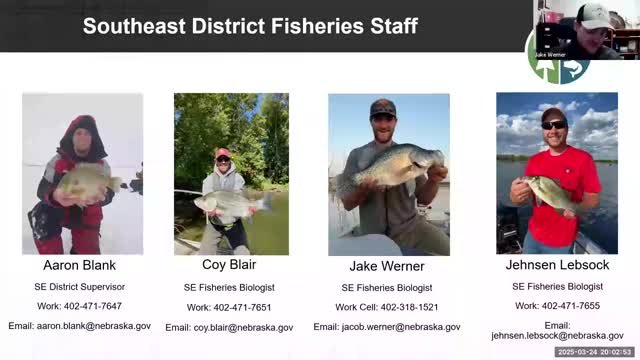Study investigates seasonal fishing patterns at Papillion's Portal Lake reservoir
May 23, 2025 | Nebraska Game and Parks Commission (NGPC), State Agencies, Organizations, Executive, Nebraska
This article was created by AI summarizing key points discussed. AI makes mistakes, so for full details and context, please refer to the video of the full meeting. Please report any errors so we can fix them. Report an error »

The Nebraska Southeast District Fisheries Meeting held on May 23, 2025, brought together local anglers and fisheries experts to discuss critical updates and initiatives impacting the region's water bodies. A key focus of the meeting was a new study aimed at understanding fish populations across different seasons, which will require community participation.
The study will involve anglers fishing at least eight days throughout the year—once in late summer, fall, winter, and spring—using both traditional methods and a new technique called LIS. Organizers are seeking volunteers to commit to this effort, emphasizing the importance of community involvement in gathering valuable data about local fish populations.
Another significant topic was the status of Portal Lake, located in the Papillion area. Recent concerns were raised about fluctuating water levels, which have dropped since last summer. Fisheries staff reported ongoing discussions with the Papio Natural Resources District and engineering experts to address these challenges. While the exact cause of the water level drop remains uncertain, engineers believe it may be linked to insufficient rainfall. They are closely monitoring the situation, particularly the stream bed below the dam, which has remained dry despite the reservoir's decline.
The meeting also touched on the growth rates of fish in newly constructed reservoirs. Experts explained the "new reservoir effect," where fish populations initially thrive after a reservoir is filled. This phenomenon is crucial for anglers looking to understand what to expect in terms of bass and bluegill populations as these ecosystems develop.
As the Nebraska Game and Parks Commission continues to address these pressing issues, they encourage community members to stay engaged and informed. The outcomes of these discussions will play a vital role in shaping the future of local fisheries and ensuring sustainable fishing practices for residents.
The study will involve anglers fishing at least eight days throughout the year—once in late summer, fall, winter, and spring—using both traditional methods and a new technique called LIS. Organizers are seeking volunteers to commit to this effort, emphasizing the importance of community involvement in gathering valuable data about local fish populations.
Another significant topic was the status of Portal Lake, located in the Papillion area. Recent concerns were raised about fluctuating water levels, which have dropped since last summer. Fisheries staff reported ongoing discussions with the Papio Natural Resources District and engineering experts to address these challenges. While the exact cause of the water level drop remains uncertain, engineers believe it may be linked to insufficient rainfall. They are closely monitoring the situation, particularly the stream bed below the dam, which has remained dry despite the reservoir's decline.
The meeting also touched on the growth rates of fish in newly constructed reservoirs. Experts explained the "new reservoir effect," where fish populations initially thrive after a reservoir is filled. This phenomenon is crucial for anglers looking to understand what to expect in terms of bass and bluegill populations as these ecosystems develop.
As the Nebraska Game and Parks Commission continues to address these pressing issues, they encourage community members to stay engaged and informed. The outcomes of these discussions will play a vital role in shaping the future of local fisheries and ensuring sustainable fishing practices for residents.
View full meeting
This article is based on a recent meeting—watch the full video and explore the complete transcript for deeper insights into the discussion.
View full meeting
